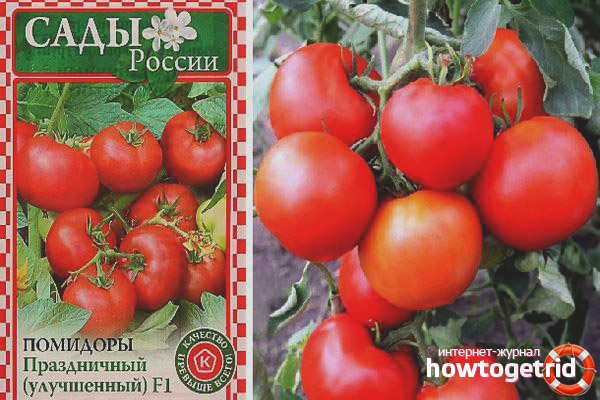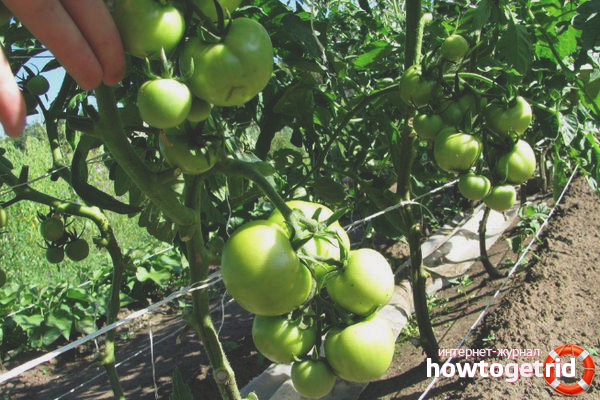The content of the article
Gardeners, gardeners and summer residents know many varieties of tomatoes - some are intended for cultivation in heat-loving regions, others can be planted and grown in the northern and eastern regions of Russia, where the climate is very variable. And there are specially bred varieties that are equally suitable for any weather conditions - they are not afraid of either the scorching sun with heat, or sharp temperature drops with a cold wind. One of these varieties that can grow in any climatic zone can be called Tomato Celebratory.
Description
- The height of the bushes is small - a maximum of 70 centimeters.
- The leaves are neither large nor small - medium sized.
- Belongs to mid-ripening, ripens in 105-110 days after the first shoots have risen.
- The best result is when grown outdoors, but even in greenhouse conditions, the crop is not bad.
- Productivity is approximately 5.2-5.3 from 1 square meter.
- The fruits are spherical red. They weigh an average of 110-115 grams, but they come across up to 150 grams.
- Street tomatoes are sweet and sour; those grown in a greenhouse have a juicy sweet taste.
Tomatoes of this variety are good to eat in fresh, natural form; juices and tomato paste are prepared from them. Also, the Festive variety is suitable for preservation for the winter.
Seedlings
Tomatoes are grown in seedlings.
- In the last decade of March, prepared and processed seeds are planted in containers with soil. It can be taken either purchased or prepared independently. Then the container is covered with polyethylene so that the seeds germinate faster. After 7-10 days, the film must be removed, and the containers put where there is a lot of light.
- After 2 leaves appear, the vegetable is dived - planted in different pots.
- 14-16 days before planting, the sprouts undergo hardening - they are carried out briefly on the street, adding daily a minute or two. Then the plants will become more resistant and adapted to outdoor conditions.
- On the site, it is recommended to plant tomatoes in the first decade of May, when the earth warms up. Festive prefers to grow on porous loam. It is advisable that the site be illuminated and there are no drafts.
- Before planting, the earth is spilled, fertilizers are applied - organic and mineral.
- It is recommended to plant bushes at a distance of 70-75 centimeters from each other, make at least 40 centimeters between the beds.
Care
Caring for a tomato is simple. What do we have to do:
- Remove excess leaves from the bush. After 55-60 days, you need to remove the leaves growing on the bottom of the bush. This is done so that the air does not stagnate. The procedure is carried out every 7 days, at a time 3 sheets are removed - no more. A day after the manipulation, the tomatoes are watered.
- Watering. Tomatoes are watered in the evening with settled warm water at least once a week. It is necessary to look after the soil and prevent its overmoistening.
- Loosening. After each watering, the soil needs to be loosened, otherwise, due to stagnation of water, the plant will have diseases.
- Fertilizers It is best to feed tomatoes when inflorescences are formed, and fruit ovary occurs. Fertilizers are used organic (litter, manure) and mineral.
What problems can a tomato have?
Gift has excellent immunity and is very resistant to diseases affecting tomatoes. But, like any plant growing in the garden, it can be attacked by insects and pests. In this case, the culture must be treated with insecticidal drugs.
If the plant is not fed enough, then the vegetables will begin to wither, and the yield will be smaller.It is possible to determine that feeding is not enough, and tomatoes lack micronutrients by the following signs:
- Iron deficiency affects crop growth - tomatoes stop growing. If things are really bad, then a white coating appears on the leaves.
- The appearance of yellow spots on the leaves indicates a lack of calcium.
- You can learn about a small amount of potassium by looking at the leaves - curls are formed on the young, and old ones are covered with burns.
- About a lack of nitrogen will tell the yellowish color of the leaves and hard tomatoes of a small size.
- If the culture receives little phosphorus, then the leaves begin to wrap inward.
Reviews
Love, 43 years old: I haven’t planted such tomatoes yet, I decided to try it. Tomato Festive unpretentious, feels great on the street - and rain, and the wind was nothing. I was especially pleased that several hot days going in a row did not bring any damage to the tomatoes - the festive party survived! And at the end of summer, he fully justified the name by arranging a holiday - he presented many delicious colorful sweet berries, from which they made delicious salads and prepared for the winter. There is only one drawback - it is very demanding on fertilizers. But I am glad that the lack of any trace elements is immediately reflected in the appearance, and the situation can be easily corrected.
Video: how to water tomatoes properly











Submit